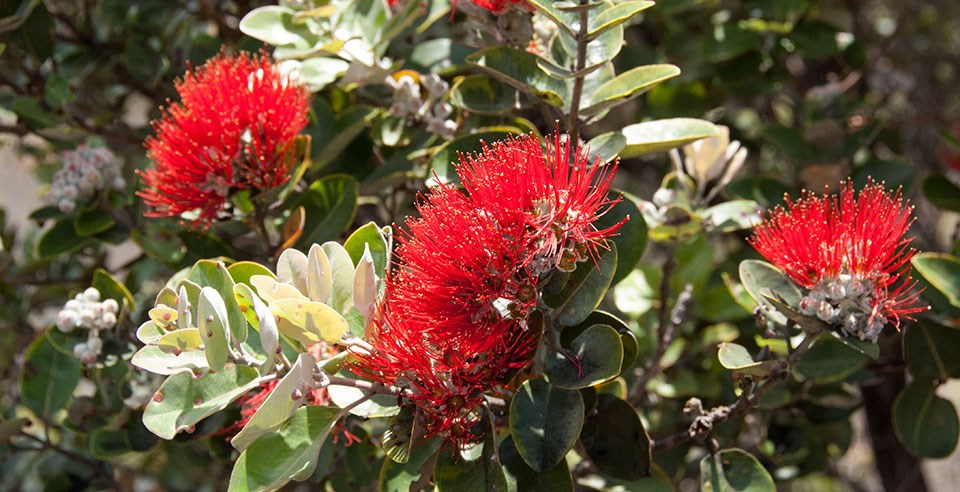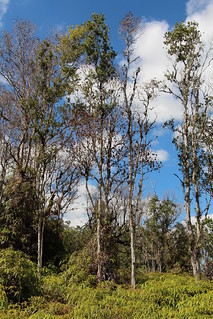
‘Ohi‘a (Metrosideros polymorpha) is the most abundant native forest tree in Hawai`i and of enormous ecological, cultural, and economic importance. Five species of endemic Metrosideros are recognized on the Hawaiian islands. Only one — M. polymorpha — is found throughout the state. Eight varieties are recognized. These varieties inhabit different environments and have adapted to selective pressures characteristic of these locations. There are at least five other species in the Metrosideros genus, each endemic to one or a few nearby islands. Blaine et al. (2022) [full citation at end of this blog] provide a helpful summary of the tree’s ecological importance and its apparently on-going speciation.
‘Ohi‘a provides habitat for endemic birds, insects, and plants, many of which are endangered. Thus, conservation of this species — and all Hawaiian Metrosideros – is vital for the conservation of countless other taxa. In addition, high elevation ʻōhiʻa forests protect vitally important watersheds across the state. For Native Hawaiians, ʻōhiʻa is a physical manifestation of multiple Hawaiian deities so is the subject of many proverbs, chants, stories, and a foundation of scared hula. Finally, the tree is beautiful!
Native Hawaiian forests face multiple threats — invasive animals and plants, wildfire, and land-use changes. Due to such threats, natural ʻōhiʻa regeneration is largely absent in most lower-elevation forests. In this case, competition with invasive species and the presence of diseases such as ʻōhiʻa rust (Austropuccinia psidii) are probably the specific causes. Multiple government and non-governmental entities have made substantial effort to mitigate these threats.
The disease Rapid ‘Ohi‘a Death (ROD) is an unprecedented threat to this species and the forests it constitutes. The disease is caused by two newly described fungal pathogens: Ceratocystis lukuohia and C. huliohia. The disease caused by C. lukuohia is more severe. To date it has been detected on the two islands farthest apart in the chain — Hawai`i (the Big Island) and Kaua‘i. C. huliohia causes a canker disease that kills trees more slowly. It is more widespread, found on Maui and O‘ahu in addition to Hawai`i and Kaua‘i. Blaine et al. (2022) and the profile here describe the two diseases’ epidemiologies, progression, impacts, and challenges.
Because of the clear threat to Hawaiian ecosystems, ecosystem services, and cultural assets, considerable effort has put into delimitation and research on possible mitigation actions since ROD was discovered in 2010. The first strategic plan covered the period 2017–2019. It focused on expanded efforts to map outbreaks, research on the epidemiology of the pathogens, and most-promising management practices. The second strategic plan covers 2020–2024. It provides for continued surveillance and improvement of these technologies; expanding outreach and public engagement; research on possible vectors of the pathogens; collection and preservation of seeds for research and future restoration; and comprehensive evaluation and development of disease resistance in ʻōhiʻa.
Soon after the causal agents were clarified, the USDA Agriculture Research Service (ARS) began screening for disease resistance. By 2016, ARS had demonstrated that five individuals from two varieties of M. polymorpha had survived inoculation by the more virulent pathogen, C. lukuohia. Their survival raised hopes that natural resistance might be present in wild populations of at least some varieties. However, more comprehensive screening of trees from throughout the species’ range is needed to provide an accurate baseline on the frequency, level, and distribution of genetic resistance to both pathogens. The goal is to produce material resistant to both pathogens that can be used to preserve the ecology, culture, and biotic communities that are dependent on this tree species.
To carry the expanded effort forward, in 2018 a collaborative partnership of state, federal, and non-profit groups was formed. Participants in the ‘Ohi‘a Disease Resistance Program (‘ODRP) include: the Akaka Foundation for Tropical Forests; USDA’s Forest Service and Agriculture Research Service; the state’s Division of Forestry and Wildlife and Agriculture Research Center; programs of the University of Hawai‘i at Manoa and at Hilo; Purdue and Arizona State universities; the Tropical Hardwood Tree Improvement and Regeneration Center; and Kalehua Seed Conservation Consulting.
Blaine et al. (2022) have now outlined a framework to guide the overall effort to identify and develop ROD resistance in M. polymorpha and, possibly, all Hawaiian Metrosideros species. The framework calls for the following activities:
(1) evaluating and operationalizing methods for inoculation-based screening and greenhouse-based production of test plants; and
(2) short-term greenhouse screenings of seedlings and rooted cuttings sampled from native Metrosideros throughout Hawai’i.
Once these tasks have been achieved, the effort is expected to expand to address:
(3) establishing field trials to validate the short-term greenhouse assays and monitor durability and stability of resistance;
(4) understanding environmental (climate, soils) and genetic (vascular architecture, wound response)
drivers of susceptibility and resistance to characterize the durability and stability of genetic resistance to ROD;
(5) developing remote sensing and molecular methods to rapidly detect ROD-resistant individuals;
(6) if necessary, conducting breeding to increase the efficacy of resistance and improve durability of ROD resistance; and
(7) supporting already established and ongoing Metrosideros conservation, including state-wide seed collection and banking, with information on not only genotypes resistant to ROD but also production of ROD-resistant seed.
Blaine et al. (2022) outline how to proceed on each step, and describe the challenges that must be overcome. Challenges range from building growing and screening capacity to handle the thousands of plants required, to developing the remote sensing tools to identify diseased trees in the forest, to identifying sites for seed orchards. Actions by ‘ODRP will focus on Stage II screening in the field to examine the durability of resistance under the wide variety of ecological conditions in which ʻōhiʻa grows and in the presence of a potentially evolving pathogen. Resistance studies must expand beyond M. polymorpha varieties from only one island (the Big Island) to include the other Hawaiian Metrosideros taxa.
Once ROD-resistant M. polymorpha trees are discovered and groundwork has been laid to satisfy initial needs for resistant tree seedlings for forest restoration, scientists can begin research into the genetic basis of ROD resistance. This knowledge will assist breeding efforts which might be necessary if resistance to one of the pathogens does not confer resistance to the other, since the goal is to provide seedlings that are resistant to both.
Blaine et al. (2022) note that the state and others continue efforts to address other aspects of ROD management. These include
1) controlling the spread of the pathogen through local quarantines on movement of infected material and increased public education on bio-sanitation for forest users;
2) testing repellants to reduce beetle attack on infected trees and subsequent frass production.
3) reducing wounding of trees by fencing more pristine forests and removing feral ungulates
SOURCE
Blaine C. Luiz, Christian P. Giardina, Lisa M. Keith, Douglass F. Jacobs, Richard A. Sniezko, Marc A. Hughes, James B. Friday, Philip Cannon, Robert Hauff, Kainana Francisco, Marian M. Chau, Nicklos Dudley, Aileen Yeh, Gregory Asner, Roberta E. Martin, Ryan Perroy, Brian J. Tucker, Ale.alani Evangelista, Veronica Fernandez, Chloe Martins-Keli.iho.omalu, Kirie Santos, Rebekah Ohara. 2022. A framework for establishing a rapid ‘Ohia death resistance program. New Forests. https://doi.org/10.1007/s11056-021-09896-5
See also the video at https://www.bigislandvideonews.com/2019/06/16/video-to-save-ohia-a-genetic-resistance-program-will-be-built/
Posted by Faith Campbell
We welcome comments that supplement or correct factual information, suggest new approaches, or promote thoughtful consideration. We post comments that disagree with us — but not those we judge to be not civil or inflammatory.
For a detailed discussion of the policies and practices that have allowed these pests to enter and spread – and that do not promote effective restoration strategies – review the Fading Forests report at http://treeimprovement.utk.edu/FadingForests.htm
